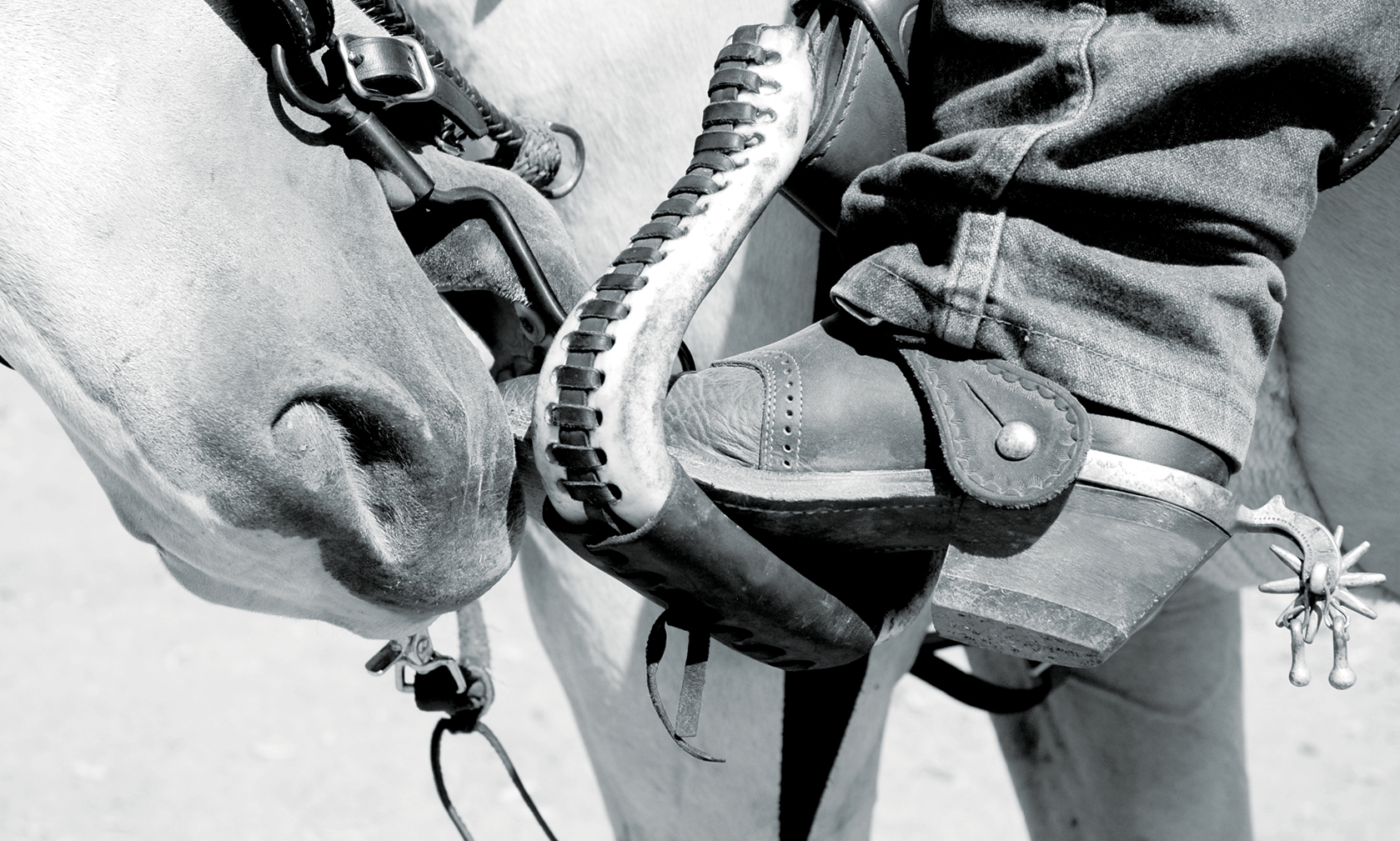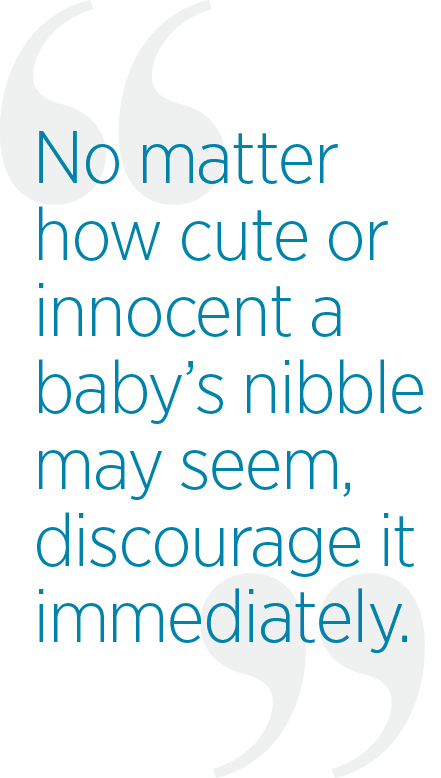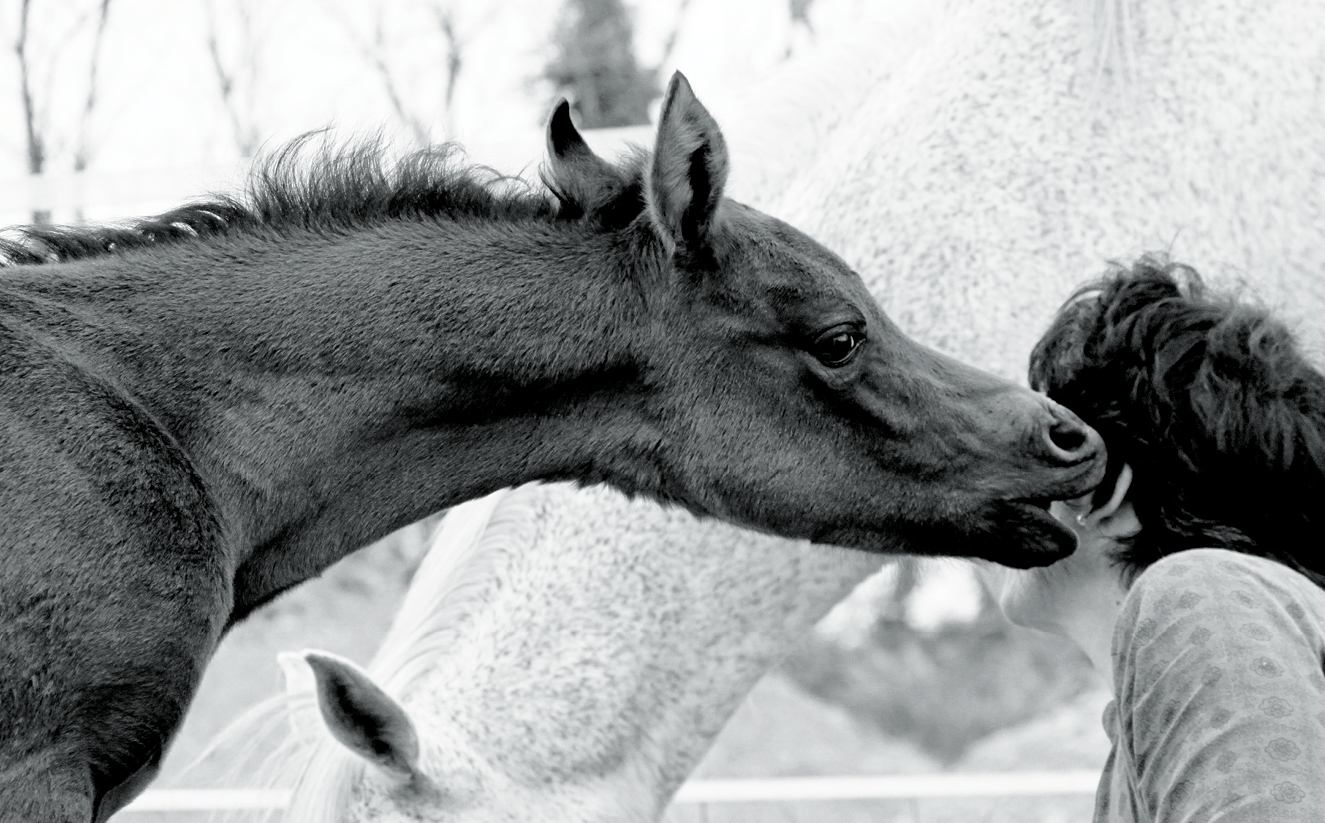Though horses aren’t fanged carnivores, they can inflict catastrophic bites with powerful jaws and teeth designed for tearing hardy vegetation. In the wild, horses use their teeth for survival in many ways, including fighting. By contrast, domestic horses must learn that using teeth to inflict harm is unacceptable.
[RELATED: SOLUTIONS FOR PROBLEM HORSE]
For horse owners, a biting horse is a liability—dangerous to you, other people, and other horses. Here, we’ll look at how horses use their teeth, why they bite, how to keep yourself safe, and ways to change the behavior of a horse that bites.
Biting in the Wild
Horses living in the wild use their teeth for grazing, interacting within a herd, and dealing with outsiders and predators.
Most biting is done by stallions, directed at other stallions to keep them from stealing mares. A herd stallion will try to chase any bachelor stallion away by biting at his rump. If the retreating stallion turns to fight, they’ll both rear and bite at each other, aiming at withers and forelegs.
Bachelor groups of males hone their skills by play fighting, which includes biting. Biting is generally offensive, whereas kicking is defensive.
Though infection can ultimately lead to death, the initial bite wounds aren’t usually fatal. A horse can kill with his teeth, though, as may be the case if he catches a coyote or other predator in a crushing bite. A stallion may kill a foal, as well, by grabbing it with his teeth and violently shaking it (it’s not entirely clear why this happens, though the stallion may believe it’s not his offspring).
Mares are generally peaceful unless a resource, such as a salt lick or water hole, is scarce. Then they’ll bite or threaten to bite to ensure their access to those resources—and the bigger the herd, the more likely the aggression. Many mares will also bite at all other horses right after giving birth to a foal. This is common maternal behavior that helps protect the newborn and ensure that it bonds with her rather than another horse.
Other situations of wild horses using their teeth are mares scolding their foals with gentle nips, mutual grooming among all herd members, and mutual grooming between a stallion and a mare in heat as part of courtship.
Biting in the Barn
Domesticated horses use their teeth in much the same way that wild horses do for grazing and mutual grooming, if they live on pasture or in a group. Horses in a group will also use their teeth to enforce a hierarchy. Stallions are uncommon among domestic horses, which leaves geldings and mares to sort out who’s dominant, and either sex can be dominant over the other.
Some geldings don’t realize they’re geldings, however, and may still behave as a stallion would, even trying to mount mares or kill foals. It’s up to stable owners or managers whether or not to board geldings and mares together; but, in many cases, they’re separated.

Domestic-horse hierarchy can involve nonlinear relationships. For example, Horse A may be dominant over Horse B who’s dominant over Horse C, yet Horse C is dominant over Horse A. The larger the group, the more relationships need to be established, which can lead to more bite wounds.
Disparities in size, age, breed, and past history play roles, as well. Size can play a bigger role than sex, as there are examples of Shetland stallions being subordinate to Welsh-size mares.
Similar to mares in the wild, a domestic mare may attack a human or horse who approaches her foal in its first few days. That behavior usually goes away after the first week. Though this behavior is seen in mild form in most mares, only about 10 percent of mares will actually attack people trying to approach the foal. Those mares are probably more aggressive in general and not completely at ease in their environment.
Safeguard Yourself & Others
Horses may bite humans in a variety of scenarios. Here are a few of them, along with ways to keep yourself and others safe.
Guarding food. This is one of the most common situations in which horses bite humans. Food is a critical resource to them and an intense focal point, even when they’re fed on a regular schedule. For that reason, a horse that’s stirred up and eager to eat can target even the feeding person with aggression and a bite.
Safeguard. When offering feed or a treat to a horse that bites or threatens to bite, stay on the opposite side of a fence or wall, and give the feed through an opening or window. Many indoor stalls are designed to facilitate this with a feed window. If your horse is on pasture and can reach over or through a fence and bite you, build a wall that has a feed window—even if it’s makeshift and temporary—along the fence near the manger.
Defending territory. Territoriality can arise in geldings and mares kept in a too-small pasture or pen. The most common scenario is a horse biting a person who enters the confined space of his stall. A territorial horse may even bite a person walking along a barn aisle by his stall.
Safeguard. Prevent a biter from having access to anyone walking past by fitting bars or a sturdy screen to any door or window openings of his stall. Have only experienced staff clean his stall or pen. If possible, shut the biter away in a paddock or adjoining stall while his own stall or pen is cleaned.
Response to procedure. Some horses will nip at a person administering health care or grooming/saddling them. This is almost always caused by the horse’s anticipation of discomfort based on previous painful experiences.
Safeguard. A horse that won’t tolerate basic grooming, hoof care, tacking up, or any other routine procedure without threatening to bite may need to be muzzled. This can be an interim solution to keep everyone around the horse safe while he’s worked with to mitigate his response.
Horse muzzle options: Tough-1 Muzzle, Dover Muzzle, or the Cigooxm Muzzle.

Protecting a foal. Again, a mare may show aggression and bite at anyone who approaches her foal, a natural response that usually fades away beyond the first week after the
foal’s arrival.
Safeguard. You need to be able to apply iodine to a newborn foal’s navel, among other care routines, and to imprint human touch as soon as possible. A mare that won’t allow access to her foal should therefore wear a halter at all times. That way, you can use a pole with a blunt hook on the tip to capture her head from a distance, then use it to keep her from charging or biting anyone tending to the foal.
Youthful biting. Foals, especially colts, commonly bite. When two or more colts are together, they bite as they play, mimicking stallion behavior. They’re often mouthy with humans, too, as they test out their teeth.
Safeguard. No matter how cute or innocent a baby’s nibble may seem, discourage it immediately. Nibbling can become full-fledged biting in a disturbingly short time.
Always keep a halter on a young biter when in his presence so you have some control over his head movements. A short lead can be attached and left on for added control.
Foal halter options: Weaver Leather halter, Tough-1 halter, or the Intrepid International halter.
Always apply mitigation techniques (below) with all youngsters. Also, be aware that being around geldings often helps decrease a colt’s impulse to bite.
Mitigate Biting Behavior
Slapping a biting horse on the muzzle is not a useful practice. It can result in head shyness and may even escalate the biting behavior by promoting an “I nip you, you slap me, I nip harder” concept.

Here are better methods for stopping and reforming a horse that bites.
Head control. Train your horse to move his head away from you on command. Have treats or another reward he values ready. In a safe situation (he’s haltered and tied or behind a screen, for example), give him a one-word voice command of your choice. Wait for him to move his head away from you—even just the smallest perceptible movement—and then reward him immediately with a treat (which should be given from a small bucket or other container, not your hand).
Now that he’s eager for more treats, give the command again, and wait for him to move his head away from you. As soon as he does, in even the smallest way, reward him. A horse can learn this “head-away” command within about 20 repetitions. Then you can use it as needed to discourage/prevent biting.
Need a treat option? Try the Manna Pro wafers.
Back-it-up control. Along the same line, a horse can be trained to back up on command. Using the same method, ask him to step back, then reward him immediately for any positive effort. Then keep asking.
In its fullest effect after consistent training, he should promptly and willingly back up multiple steps on command—well out of biting range—before getting his treat. This takes patience and repetition, but ultimately, you’ll be able to command him to back away from you even at feeding time. To reinforce the training, insist that he always back up before receiving his meal.
Mindful grooming. For a horse that bites during grooming, consider first having a veterinarian examine him to rule out a health problem. Then, take pains never to inflict discomfort as you groom him.
Pay attention to which parts of his body you’re tending to when he flinches or threatens to bite. Groom close to that spot, and when he’s relaxed and not threatening you, give him a treat. Work closer to his sensitive spot, and if he stays relaxed, give him another treat.
As long as there’s no medical issue and you remain gentle, he should eventually allow you to groom his touchy spot—and when he does, reward him.
Mindful saddling. Apply the same technique for a horse that bites while being saddled. Do up the cinch loosely, give him a treat, then walk him around. Repeat this process as you gradually tighten the cinch. Be patient, and don’t try to cut corners. With every tightening of the cinch, give him a treat and walk him. Eventually, he should accept the process much more positively.
If the behavior persists, however, have your veterinarian check for musculoskeletal problems that may make tightness around his ribs painful.
Read More: 3 RULES FOR DEALING WITH QUIRKY HORSES






